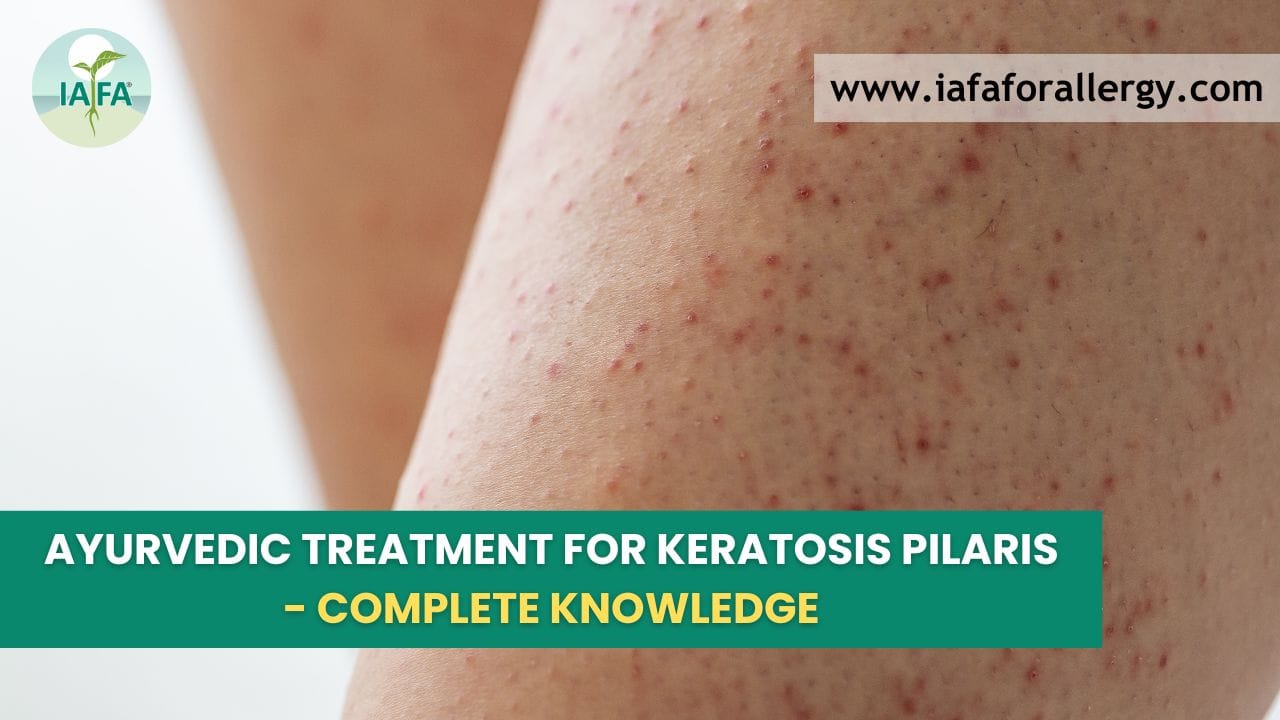Keratosis pilaris is often called “chicken skin” due to its appearance of small, rough, and protruded bumps on the skin. It is most commonly seen on the neck, shoulders, upper arms, buttocks, thighs, and legs. It is caused by the excess production of a protein called keratin which blocks the hair follicles and makes the skin look unsightly. Despite being painless and harmless, people often feel self-conscious about the condition’s appearance. Although there are conventional medications used to treat keratosis pilaris, no one can get the precise and the recurrence is quite common along with serious skin adverse reactions. Hence, alternative medicine, ayurveda plays a key role in analyzing the seriousness of the condition, finding out the root cause, and Keratosis pilaris Ayurvedic treatment,
Here’s a case study of a patient who was treated successfully with Ayurvedic treatment and got rid of keratosis pilaris without any worry of recurrence and side effects.
At IAFA®, Dr. Sahil Gupta brings 15+ years of Ayurvedic practice to treating skin disorders. He looks beyond surface symptoms, identifying the root imbalance of Vata and Kapha that triggers these bumps. He has helped hundreds of patients with Keratosis Pilaris through personalized herbal therapies and gentle detox.
Before delving into the Keratosis pilaris Ayurvedic treatment, let’s explore the Ayurvedic perspective on the condition and its root causes.
What Does Ayurveda Say About Keratosis Pilaris?
In ayurveda, keratosis pilaris is often related with “padmini kantaka” a type of “kshudra roga”, a harmless skin condition caused by an imbalance of vata and kapha doshas. The main root cause of the disease is imbalanced doshas, so we follow two types of treatment approaches to clear the skin and make the patient free from the condition. The first one is “Sodhana chikitsa” and the other is “Shamana chikitsa”. We will discuss these in a detailed treatment plan. Ayurveda recommends both internal medicine for the elimination of root causes and also external medications to clear the skin.
Keratosis Pilaris Ayurvedic Treatment
Let’s explore both the shodhana and shamana chikitsa and how they contribute to eliminating the disease. Sodhana chikitsa is a purification therapy where the patient is treated with various purification processes to eliminate ama visha (toxins) from the body thereby boosting the immunity to fight against the disease and the other is shamana chikitsa which is the pacification process, pacifying the vitiated doshas like in our case kapha and vata doshas.
Shodhana Chikitsa – Purification Therapy
It involves the panchakarma treatment, the deep cleansing of the body from the inside eliminating the toxins thereby getting the doshas in balance. The following are the 5 panchakarma procedures and pooravakarma followed in the Keratosis pilaris Ayurvedic treatment:
- Swedana (Sweating Therapy)
- Vamana (therapeutic vomiting),
- Virechana (therapeutic purgation),
- Basti (therapeutic enema),
- Nasya (nasal administration of medicated oils), and
- Raktamokshana (blood purification)
By eliminating accumulated toxins and inflammatory mediators, it strengthens the immune system’s ability to combat the condition. Scientific studies have also proved that shodhana chikitsa helps amazingly in getting rid of keratosis pilaris, here’s a research paper for your reference.
Shamana Chikitsa – Pacification Therapy
It involves the use of herbs, diet, and lifestyle modifications to eliminate the root cause of the disease. We will discuss one by one in detail.
Herbs Used for Keratosis Pilaris Treatment
These are the most potent herbs used to treat any kind of skin disease, they are highly useful in keratosis pilaris. These herbal medicines or herbs help in moisturising the skin, eliminating the toxins from the skin, and killing any bacteria and fungi.
- Coconut oil rich in fatty acids, provides excellent moisture to the skin and prevents dryness. Dry skin can exaggerate the condition and can invite other skin conditions like Keratosis pilaris.
- Neem oil, the best antimicrobial and antibacterial, helps in killing the bacteria on the skin and improves the condition.
- Ghee boiled cooked with the decoction of single herbs such as neem and many more with honey, is an ancient remedy and treatment for Keratosis pilaris.
- Other herbs that are useful are turmeric, eladi oil, and licorice extract.
Diet Plan for Keratosis Pilaris Treatment
A diet plan includes the foods that are recommended to eat and the foods to avoid. The foods to avoid are much more important than what you eat because they can worsen the condition. Ayurveda is against the consumption of packaged, processed, and ultra-processed foods as these can worsen health and are the main culprit for many of diseases nowadays.
- Ayurveda advised to follow an anti-inflammatory and antioxidant-rich diet. So lots of veggies, green leafy vegetables, fresh fruits, and good fats should be a part of your diet.
- Prioritise omega 3 fatty acids, consume seeds like flax seeds, chia seeds, and lean proteins of fish to provide good antioxidants to the skin.
- Manage the intake of gluten and dairy as it can worsen the condition.
- Avoid packaged, canned foods.
- Stay hydrated.
- Include foods that are naturally anti-inflammatory and boost immunity.
Lifestyle Modifications for Keratosis Pilaris Treatment
- Use good natural moisturisers to keep skin hydrated.
- Have plenty of fluids and water.
- Avoid harsh chemicals on the skin.
- Avoid skin exposure to extreme weather conditions.
- Avoid fabrics that cause irritation.
- Avoid tight clothing.
When to Consult an Ayurvedic Doctor
You should consult with an ayurvedic doctor, if;
- Your condition triggers every winter or despite home care
- Medicated creams offer only temporary relief
- You want a safe, targeted herbal treatment for permanent solution.
At IAFA®, Dr. Sahil Gupta offers personalized care to heal skin from the root.

Conclusion
Keratosis pilaris is a harmless skin condition but many consider it unsightly causing discomfort to their appearance. Ayurveda offers a perfect and permanent Keratosis pilaris treatment solution to get rid of this condition and has been proven by many research studies too. If you are still suffering from keratosis pilaris, book an online consultation with IAFA Ayurveda experts and get a natural treatment for the disease.








